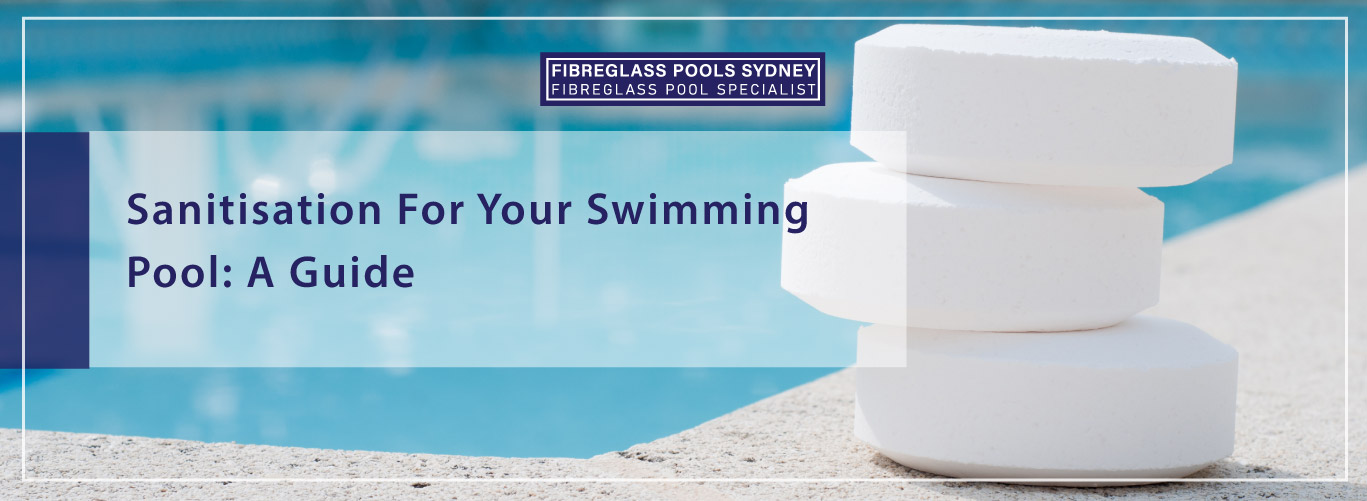Sanitisation For Your Swimming Pool: A Guide
Swimming pools provide a much-needed and refreshing oasis during the scorching hot summer months. A well-maintained and properly sanitised pool not only offers a cool escape but also ensures a safe and healthy environment to swim in. However, it is crucial to understand the intricacies of pool sanitation to avoid any potential issues.

Misunderstandings and mismanagement can lead to imbalanced chemical levels, which not only pose health risks but can also cause significant damage to the pool infrastructure. By having a comprehensive understanding of pool sanitation practices and regularly monitoring and adjusting the chemical levels, you can enjoy a pristine and inviting swimming pool all summer long.
Understanding Pool Sanitation
Pool sanitation is a crucial process that involves effectively managing the chemical balance of your pool’s water to ensure it remains safe, hygienic, and crystal clear. This is primarily achieved through the use of chlorination, a powerful method that effectively eliminates harmful bacteria, viruses, and even stubborn algae. By maintaining the optimal chemical balance in your pool, you can enjoy a refreshing and enjoyable swimming experience with peace of mind, knowing that your pool water is clean and healthy.
Chlorine: The Mainstay of Pool Sanitisation
Chlorine, widely recognised as the gold standard for pool sanitation, offers various forms such as tablets, liquid, or granules. When introduced into water, chlorine undergoes a transformation, breaking down into a combination of chemicals including hypochlorous acid and hypochlorite ion. These powerful compounds work diligently to eliminate pathogens and bacteria by specifically targeting and disrupting the lipids within their cells, ultimately rendering them harmless. By leveraging this intricate chemical process, chlorine ensures a thorough and effective sanitisation of pool water, providing a safe and enjoyable swimming experience for all.
Balancing Your Pool's pH Levels
Maintaining the pH level of your pool is of utmost importance when it comes to maximising the efficiency of chlorine. It is recommended to keep the pH slightly alkaline, ideally between 7.2 and 7.6, as this ensures optimal chemical balance. When the pH level is too high or too low, it can adversely affect the effectiveness of chlorine, leading to potential skin and eye irritation. By diligently monitoring and adjusting the pH level, you can create a safe and enjoyable swimming environment for everyone.

Shocking Your Pool
“Shocking” your pool involves significantly increasing the chlorine levels for a brief period to effectively eliminate bacteria. This important maintenance practice is usually carried out on a weekly basis or when you notice signs such as cloudy water or a strong smell of chlorine. By implementing this process, you ensure that your pool remains clean, safe, and inviting for a refreshing swim.
Alternative Sanitisation Methods
While chlorine is the most used disinfectant in pools, there are alternative options available. Bromine, a close relative to chlorine, is often preferred in hot tubs because of its stability at higher temperatures. Another alternative is saltwater pools, which utilise a generator to convert salt into chlorine, providing a more natural and gentle swimming experience. These alternatives offer pool owners a range of choices to suit their specific needs and preferences.
Regular Testing
Regularly testing the pool water on a weekly basis is crucial to ensure optimal chlorine and pH levels. Fortunately, there are numerous user-friendly at-home testing kits readily available in the market. These kits are designed to be simple to use and provide immediate and accurate results, making it convenient for pool owners to maintain a healthy and well-balanced swimming environment.
The Importance of Pool Filtration
Another key aspect of maintaining a sanitised swimming pool is implementing an efficient filtration system. This works in tandem with the chemical sanitation process, aiding in the removal of debris, dirt, and microscopic organisms. Swimming pools usually have one of three types of filters: sand, cartridge, or diatomaceous earth.
Sand filters are economical and low maintenance, trapping debris in a bed of sand. Cartridge filters are more efficient, capturing smaller particles, but require more frequent cleaning. Diatomaceous earth filters, while more expensive, are the most effective, filtering out even microscopic particles.
Regularly cleaning and servicing your pool filter not only ensures its optimal function, but also prolongs its lifespan. By maintaining a clean filter, you can keep your pool water clear, clean, and inviting.

The Role of Circulation in Pool Sanitation
Proper water circulation is another critical component of pool sanitation. Stagnant water can become a breeding ground for harmful bacteria and algae. Hence, regular circulation helps distribute pool chemicals evenly and aids in filtering debris and other particles. The pump plays a key role in this process, pushing water through the filter and returning it to the pool.
To maintain effective circulation, it’s recommended to run your pool pump for at least 8 hours per day. Moreover, adjusting return jets so water spins around the pool can improve circulation, reduce dead spots, and promote healthier, cleaner water.
Remember, every element of pool maintenance plays a significant part in ensuring you have a clean and safe swimming experience. Balancing these elements requires diligence, but the result is a sparkling clean pool that you and your family can enjoy without worry.
Professional Help
Enlisting the help of professionals for routine maintenance can keep your pool sparkling clean and prolong its lifespan. They can also advise on any equipment or infrastructure upgrades that can enhance your swimming experience and safety.
In conclusion, maintaining a fibreglass pool is not as daunting as it may seem. Regular testing, understanding the role of chlorine and pH, and knowing when to seek professional help are all key. Ensuring your pool is a safe, enjoyable space for all is worth the effort.
If you’re considering a fibreglass pool, our team at Fibreglass Pools Sydney is here to help. With years of experience in the industry, we provide seamless installations, ensuring your swimming pool not only looks fantastic but is built to last. Our expertise extends to maintaining the chemical balance and optimising the sanitation of your fibreglass pool. Contact us today to transform your backyard into your personal paradise.
Sanitisation For Your Swimming Pool: A Guide
Swimming pools provide a much-needed and refreshing oasis during the scorching hot summer months. A well-maintained and properly sanitised pool not only offers a cool escape but also ensures a safe and healthy environment to swim in. However, it is crucial to understand the intricacies of pool sanitation to avoid any potential issues.

Misunderstandings and mismanagement can lead to imbalanced chemical levels, which not only pose health risks but can also cause significant damage to the pool infrastructure. By having a comprehensive understanding of pool sanitation practices and regularly monitoring and adjusting the chemical levels, you can enjoy a pristine and inviting swimming pool all summer long.
Understanding Pool Sanitation
Pool sanitation is a crucial process that involves effectively managing the chemical balance of your pool’s water to ensure it remains safe, hygienic, and crystal clear. This is primarily achieved through the use of chlorination, a powerful method that effectively eliminates harmful bacteria, viruses, and even stubborn algae. By maintaining the optimal chemical balance in your pool, you can enjoy a refreshing and enjoyable swimming experience with peace of mind, knowing that your pool water is clean and healthy.
Chlorine: The Mainstay of Pool Sanitisation
Chlorine, widely recognised as the gold standard for pool sanitation, offers various forms such as tablets, liquid, or granules. When introduced into water, chlorine undergoes a transformation, breaking down into a combination of chemicals including hypochlorous acid and hypochlorite ion. These powerful compounds work diligently to eliminate pathogens and bacteria by specifically targeting and disrupting the lipids within their cells, ultimately rendering them harmless. By leveraging this intricate chemical process, chlorine ensures a thorough and effective sanitisation of pool water, providing a safe and enjoyable swimming experience for all.
Balancing Your Pool's pH Levels
Maintaining the pH level of your pool is of utmost importance when it comes to maximising the efficiency of chlorine. It is recommended to keep the pH slightly alkaline, ideally between 7.2 and 7.6, as this ensures optimal chemical balance. When the pH level is too high or too low, it can adversely affect the effectiveness of chlorine, leading to potential skin and eye irritation. By diligently monitoring and adjusting the pH level, you can create a safe and enjoyable swimming environment for everyone.

Shocking Your Pool
“Shocking” your pool involves significantly increasing the chlorine levels for a brief period to effectively eliminate bacteria. This important maintenance practice is usually carried out on a weekly basis or when you notice signs such as cloudy water or a strong smell of chlorine. By implementing this process, you ensure that your pool remains clean, safe, and inviting for a refreshing swim.
Alternative Sanitisation Methods
While chlorine is the most used disinfectant in pools, there are alternative options available. Bromine, a close relative to chlorine, is often preferred in hot tubs because of its stability at higher temperatures. Another alternative is saltwater pools, which utilise a generator to convert salt into chlorine, providing a more natural and gentle swimming experience. These alternatives offer pool owners a range of choices to suit their specific needs and preferences.
Regular Testing
Regularly testing the pool water on a weekly basis is crucial to ensure optimal chlorine and pH levels. Fortunately, there are numerous user-friendly at-home testing kits readily available in the market. These kits are designed to be simple to use and provide immediate and accurate results, making it convenient for pool owners to maintain a healthy and well-balanced swimming environment.
The Importance of Pool Filtration
Another key aspect of maintaining a sanitised swimming pool is implementing an efficient filtration system. This works in tandem with the chemical sanitation process, aiding in the removal of debris, dirt, and microscopic organisms. Swimming pools usually have one of three types of filters: sand, cartridge, or diatomaceous earth.
Sand filters are economical and low maintenance, trapping debris in a bed of sand. Cartridge filters are more efficient, capturing smaller particles, but require more frequent cleaning. Diatomaceous earth filters, while more expensive, are the most effective, filtering out even microscopic particles.
Regularly cleaning and servicing your pool filter not only ensures its optimal function, but also prolongs its lifespan. By maintaining a clean filter, you can keep your pool water clear, clean, and inviting.

The Role of Circulation in Pool Sanitation
Proper water circulation is another critical component of pool sanitation. Stagnant water can become a breeding ground for harmful bacteria and algae. Hence, regular circulation helps distribute pool chemicals evenly and aids in filtering debris and other particles. The pump plays a key role in this process, pushing water through the filter and returning it to the pool.
To maintain effective circulation, it’s recommended to run your pool pump for at least 8 hours per day. Moreover, adjusting return jets so water spins around the pool can improve circulation, reduce dead spots, and promote healthier, cleaner water.
Remember, every element of pool maintenance plays a significant part in ensuring you have a clean and safe swimming experience. Balancing these elements requires diligence, but the result is a sparkling clean pool that you and your family can enjoy without worry.
Professional Help
Enlisting the help of professionals for routine maintenance can keep your pool sparkling clean and prolong its lifespan. They can also advise on any equipment or infrastructure upgrades that can enhance your swimming experience and safety.
In conclusion, maintaining a fibreglass pool is not as daunting as it may seem. Regular testing, understanding the role of chlorine and pH, and knowing when to seek professional help are all key. Ensuring your pool is a safe, enjoyable space for all is worth the effort.
If you’re considering a fibreglass pool, our team at Fibreglass Pools Sydney is here to help. With years of experience in the industry, we provide seamless installations, ensuring your swimming pool not only looks fantastic but is built to last. Our expertise extends to maintaining the chemical balance and optimising the sanitation of your fibreglass pool. Contact us today to transform your backyard into your personal paradise.



